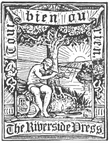Transcriber’s Note
Cover created by Transcriber, using an illustrationfrom the original book, and placed in the Public Domain.
Works by the same Author.
PROBLEMS OF LIFE AND MIND. TheFoundations of a Creed. Two Volumes. Octavo.Per volume, $3.00.
Contents: The Method of Science and its Applications toMetaphysics—The Rules of Philosophizing—PsychologicalPrinciples—The Limitations of Knowledge—The Principlesof Certitude—From the Known to the Unknown—Matterand Force—Force and Cause—The Absolute in theCorrelations of Feeling and Motion.
THE STORY OF GOETHE’S LIFE. NewEdition. One volume. 16mo. With Portrait.$1.50.
*** For sale by all Booksellers. Sent, post-paid, on receipt ofprice by the Publishers,
HOUGHTON, MIFFLIN & CO., BOSTON.
THE
PHYSICAL BASIS OF MIND.
With Illustrations.
BEING THE SECOND SERIES
OF
PROBLEMS OF LIFE AND MIND.
BY
GEORGE HENRY LEWES.

BOSTON AND NEW YORK:
HOUGHTON, MIFFLIN AND COMPANY.
The Riverside Press, Cambridge.
1891.
AUTHOR’S EDITION.
From Advance Sheets.
The Riverside Press, Cambridge, Mass., U. S. A.
Printed by H. O. Houghton & Company.
v
PREFACE.
The title indicates that this volume is restricted to thegroup of material conditions which constitute the organismin relation to the physical world—a group whichfurnishes the data for one half of the psychologist’squest; the other half being furnished by historical andsocial conditions.
The Human Mind, so far as it is accessible to scientificinquiry, has a twofold root, man being not only an animalorganism but an unit in the social organism; and hencethe complete theory of its functions and faculties mustbe sought in this twofold direction. This conception(which has been declared “to amount to a revolution inPsychology”), although slowly prepared by the growingconviction that Man could not be isolated from Humanity,was first expounded in the opening volume of theseProblems of Life and Mind; at least, I am not awarethat any predecessor had seen how the specially humanfaculties of Intellect and Conscience were products ofsocial factors co-operating with the animal factors.
In considering the Physical Basis a large place mustbe assigned to the mechanical and chemical relationswhich are involved in organic functions; yet we have torecognize that this procedure of Analysis is artificial andpreparatory, that none of its results are final, none representthe synthetic reality of vital facts. Hence oneleading object of the following pages has been everywhereto substitute the biological point of view for thevi